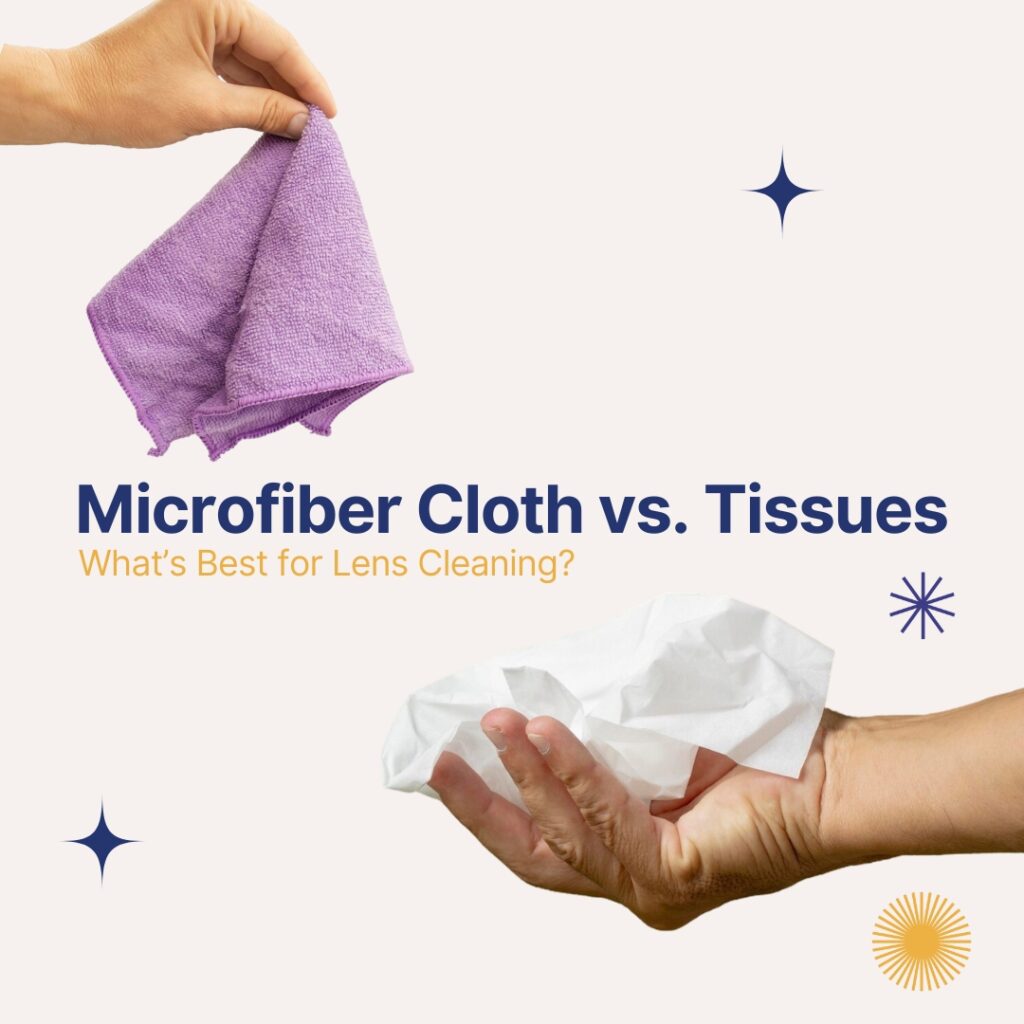Microfiber Cloth vs. Tissues: What’s Best for Lens Cleaning?

When it comes to keeping your eyeglasses, sunglasses, or camera lenses clean, the method you choose matters just as much as the cleaner you use. One of the most common questions lens users ask is: “Can I use tissues to clean my glasses?” The short answer? no! While tissues may seem convenient, they’re far from ideal. In contrast, using a microfiber cloth for lenses is the safer, more effective choice—recommended by opticians and manufacturers alike. In this article, we’ll compare microfiber vs tissues, explain why microfiber is considered the best lens cleaning material, and offer tips for keeping your cloth clean and long-lasting. 1. Microfiber vs. Tissues: What’s the Difference? Not all cleaning cloths are created equal. Let’s look at how microfiber cloths and tissues differ in material, effectiveness, and risk. Microfiber Cloths: Made from ultra-fine synthetic fibers (polyester and polyamide) Specifically designed to lift and trap dust, oil, and smudges Non-abrasive and safe on coatings Reusable and washable Tissues (Facial or Paper Towels): Made from wood pulp fibers Designed to be soft for skin—not lenses Leave behind lint or fibers Can scratch delicate coatings if debris is present While tissues might seem harmless, especially in a pinch, they can lead to micro-abrasions that gradually wear down your lenses. 2. Why Microfiber Is the Best Cloth for Glasses Choosing the best cloth for glasses means considering both safety and effectiveness. Microfiber cloths outperform tissues on every front. Key Benefits of Microfiber Cloths for Lenses: • Scratch-Free Cleaning Microfiber’s ultra-fine texture gently lifts dirt and smudges without grinding particles into your lenses—critical for maintaining anti-reflective or blue-light coatings. • Lint-Free Finish Unlike tissues, which often leave tiny fibers or streaks behind, microfiber cloths for lenses are tightly woven to ensure a clean, streak-free shine. • Reusable & Eco-Friendly A single microfiber cloth can be washed and reused dozens of times, making it more sustainable (and cost-effective) than disposable options. • Safe for All Lens Types Whether you’re cleaning prescription glasses, sunglasses, reading glasses, or camera lenses, microfiber cloths are universally safe. Pairing a microfiber cloth with a gentle lens cleaner like Rinsol Specs & Lens Cleaner enhances results—removing oil, dust, and smudges without risking damage. 3. Why Tissue Cleaning Glasses Is a Bad Habit Cleaning your lenses with tissues, napkins, or even the corner of your shirt may feel convenient, but it comes with significant drawbacks. Risks of Using Tissues on Glasses: Scratches: Tissues may contain rough fibers or trapped debris that can cause microscopic scratches. Residue: Most tissues leave lint or streaks, especially when used without a proper cleaning solution. Lack of Control: Thin paper can tear or smear dirt across the surface rather than lifting it away. 4. Lens Cleaning Tips for Best Results Cleaning your lenses the right way goes beyond the cloth itself. Here’s how to get the best results and keep your eyewear crystal clear: Effective Lens Cleaning Steps: Wash Your Hands Use mild soap and water before handling your lenses or cloth. Apply a Lens Cleaner Spray a small amount of a non-alcoholic, lens-safe cleaner like Rinsol to each side of the lens. Wipe with a Clean Microfiber Cloth Use gentle, circular motions. Avoid pressing too hard. Avoid Reusing Dirty Cloths A dirty cloth can spread more grime—or scratch your lenses. Don’t Use Hot Water Extreme heat can warp lens coatings or frames. By following these lens cleaning tips, you can preserve clarity and prolong the life of your eyewear. 5. How to Clean and Maintain Your Microfiber Cloth Your microfiber cloth needs regular cleaning to stay effective. Dirt, oils, and grime can build up over time, reducing its cleaning power and increasing the risk of scratching. Tips for Cleaning Microfiber Cloths: Hand Wash or Gentle Machine Wash Use cold water and a mild detergent. Avoid fabric softeners—they coat the fibers and reduce absorbency. Air Dry Only Let it air dry flat. Avoid heat drying, which can damage the fibers. Store It Clean Keep your eyeglass cleaning cloth in a clean, dry pouch or case to prevent contamination with dust or debris. Rotating between 2–3 microfiber cloths ensures you always have a clean one on hand for eyeglass cleaning or camera lens touch-ups. Final Thoughts: Choose the Best Lens Cleaning Material Your lenses are a daily investment in your vision, comfort, and appearance. Whether you wear glasses for reading, screen work, or fashion, proper cleaning is key. Ditch the tissues. For safe, streak-free, and scratch-free results, microfiber cloths are hands down the best lens cleaning material available today. Pair them with a reliable cleaner like Rinsol Specs & Lens Cleaner to make lens maintenance effortless and safe. Making this small switch can have a lasting impact on the clarity and lifespan of your eyewear.
